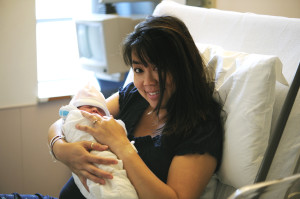
Editor’s Note: In this week’s post, Lisa Sams discusses the evolution of patient expectations and engagement and poses questions about using lessons learned to accelerate change. We encourage your feedback and responses to these questions. Please feel free to share in the comments section following the post.
“Our Patients Expected, Better . . .”
He wiped her sweaty face, rubbed her aching lower back, and breathed with her through every contraction. After 12 long hours of labor, their son took his first breath and was laid gently on his mother’s belly, where loving strokes welcomed him to the world. Quietly, the clinicians played their supporting role as the new family awakened to the wonder of life.
She had no heavy drugs, no 3-liter enema, no shaving of her pubic hair, and no rush down the hall to the cold, green-tiled “delivery room.” She was in a birthing room and her husband was allowed to be with her. In the past, the “labor deck” was restricted to patients and staff members. Fathers sat or paced in the “fathers’ waiting room,” waiting for the doctor to announce the birth. What brought about the dramatic shift in the 1970s from Victorian-style labor and birth, controlled by nurses and doctors, to the concept of family-centered care? The answer: women and their families. They learned from childbirth education that using scopolamine to drown out memories of labor was not good practice. And that enemas and shaving, which were seen as routine care, were not necessary. Women now understood that the first hour of life was a precious time to spend with a newborn as those tiny eyes sought his or her mother’s face and baby nuzzled into mother’s breast. This babe was connecting his mother’s voice—heard while in the womb—with her face. Women learned that a healthy newborn did not need to be whisked off to nursery to have routine hospital care disrupt this once-in-a-lifetime moment. Yet we clinicians had long seen birth as our territory, and we set the rules for visiting hours, for if and when a father could see his child and for when a baby could nurse from the breast. That all changed when women and their families learned something about the research on and the safety of treating birth as a normal event when mom and babe were healthy. They suddenly had power. And we clinicians did not always like it, but practice changed because our patients’ questions helped us seek and adopt evidence to improve their care. Sams, L. (2010) Your Hospital Care: Expect the Best a Guide for Patients and Families
The Lessons
We think of “patient engagement” as a new concept—a budding philosophy for healthcare—that will cure our problems with medication errors, infections and other disconnects in the delivery of care. It has even been called a “blockbuster drug” for healthcare. The term itself lacks clarity and as research shows, this leads to confusion about what is really intended when we talk about engaging patients.
This story is about engagement and the improvements in care and its outcomes that followed. So what can we take away and apply today from the change in maternal newborn care?
First:
Our patients and families drove change in maternal-newborn care through the knowledge they gained in childbirth education. Although many clinicians worked to institute change in their organizations, the larger culture of care was anchored in ritual and routine, not best evidence. Sadly, today we have a plethora of examples of routine remaining and adoption of evidence-based care lagging behind. CAUTI (catheter-associated urinary tract infection) is one example. When 13,000 people die as a result of the culture of care relying on routine rather than evidence, change is long overdue.
Questions to Consider:
Can we adapt the childbirth education model to a model for community education about safe care to prevent infections, medication errors, and falls? If so, how?
Second:
The birth story is about change in the way care is rendered, making patients’ needs the central focus. It was not an easy transition, and there were many growing pains as we began to engage more effectively with patients and families. Today, patients tell us we do not listen and we do not explain things in a way they can understand. Hospitals are punished for these patient concerns through HCAHPS (Hospital Consumer Assessment of Healthcare Providers and Systems) scores. Again, the culture of care blocks basic human needs, especially when technology demands 45% of clinician time for documentation, eye contact is lost, and listening becomes secondary to interfacing with computer screens. Technology does present barriers to effective patient-clinician communication. Though a useful tool, technology can distract from and interfere with the care itself, as many studies have demonstrated.
Questions to Consider:
Will engaging patients and families in finding solutions to technology distractions lead to more time for active listening and sharing of knowledge? What are your suggestions for starting this conversation? We look forward to your comments.






